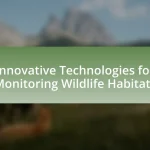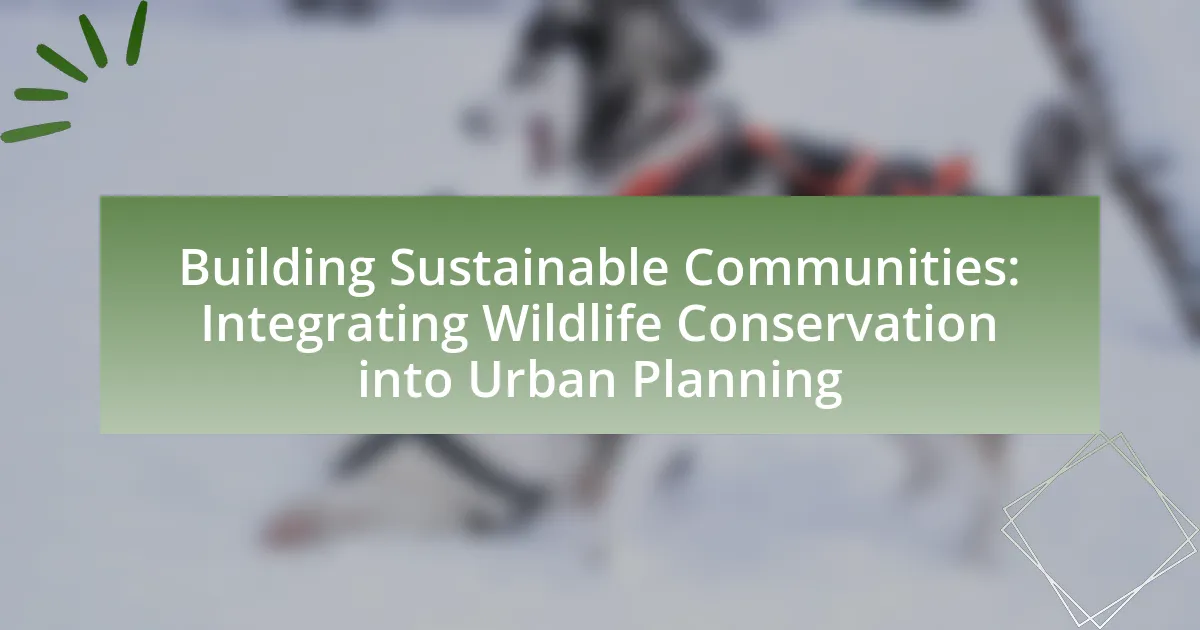The article focuses on strategies for educating communities about endangered species, emphasizing the importance of community engagement, hands-on conservation activities, and multimedia resources. It outlines how effective education fosters awareness, promotes active participation in conservation efforts, and leads to behavioral changes regarding environmental issues. Key methods discussed include interactive workshops, community programs, and partnerships with various organizations, highlighting successful case studies that demonstrate the impact of these educational initiatives on conservation outcomes. The article also addresses challenges educators face, misconceptions about endangered species, and the role of local governments in supporting community education efforts.
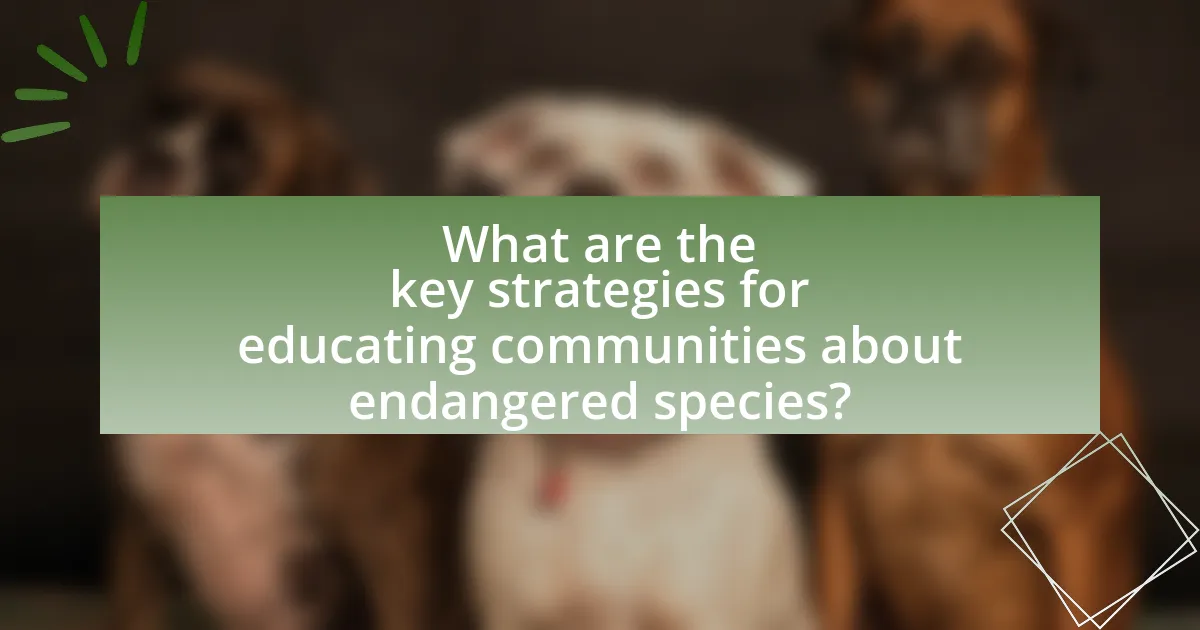
What are the key strategies for educating communities about endangered species?
Key strategies for educating communities about endangered species include community engagement, hands-on conservation activities, and the use of multimedia resources. Community engagement fosters local ownership and responsibility, as seen in programs where residents participate in wildlife monitoring, which has been shown to increase awareness and advocacy for endangered species. Hands-on conservation activities, such as habitat restoration projects, allow community members to directly contribute to the preservation of species, reinforcing the importance of biodiversity. Additionally, utilizing multimedia resources, including documentaries and social media campaigns, effectively disseminates information and raises awareness, as evidenced by successful campaigns that have reached millions and prompted action for endangered species conservation.
Why is community education important for the conservation of endangered species?
Community education is crucial for the conservation of endangered species because it fosters awareness and promotes active participation in conservation efforts. Educated communities are more likely to understand the ecological importance of endangered species and the threats they face, leading to increased support for conservation initiatives. For instance, studies have shown that community-led conservation programs, such as those in Madagascar, have successfully reduced deforestation rates and increased local biodiversity by engaging residents in sustainable practices. This demonstrates that informed communities can effectively contribute to the protection of endangered species through advocacy, habitat preservation, and responsible resource management.
What role does awareness play in protecting endangered species?
Awareness plays a crucial role in protecting endangered species by fostering public understanding and engagement in conservation efforts. Increased awareness leads to informed communities that can advocate for policies, support conservation initiatives, and participate in habitat preservation activities. For instance, studies show that educational programs about endangered species can significantly increase community involvement in local conservation efforts, as evidenced by the success of initiatives like the Endangered Species Act in the United States, which relies on public support and awareness to enforce protections.
How can community education lead to behavioral changes regarding conservation?
Community education can lead to behavioral changes regarding conservation by increasing awareness and understanding of environmental issues. When communities engage in educational programs, they learn about the importance of biodiversity and the impact of human activities on ecosystems. For instance, studies have shown that community-based conservation education initiatives can significantly improve local attitudes towards wildlife protection, as evidenced by a 2018 study published in the Journal of Environmental Management, which found that participants in such programs were 40% more likely to adopt sustainable practices. This increased knowledge fosters a sense of responsibility and encourages individuals to take action, such as participating in conservation efforts or advocating for policy changes.
What methods can be used to effectively educate communities?
Effective methods to educate communities include interactive workshops, community engagement programs, and the use of digital platforms. Interactive workshops allow participants to engage directly with experts, fostering a deeper understanding of endangered species and conservation efforts. Community engagement programs, such as local conservation projects, encourage hands-on involvement, which has been shown to increase awareness and commitment to environmental issues. Digital platforms, including social media and educational websites, can disseminate information widely and reach diverse audiences, enhancing accessibility to educational resources. Research indicates that these methods significantly improve knowledge retention and community involvement in conservation initiatives.
How can workshops and seminars enhance understanding of endangered species?
Workshops and seminars enhance understanding of endangered species by providing interactive learning experiences that engage participants directly with the subject matter. These events often feature expert speakers who share current research, conservation strategies, and real-world case studies, which help attendees grasp the complexities surrounding endangered species. For instance, a seminar might present data showing that over 1 million species are at risk of extinction, according to the Intergovernmental Science-Policy Platform on Biodiversity and Ecosystem Services (IPBES). This factual context emphasizes the urgency of conservation efforts and fosters a deeper appreciation for biodiversity. Additionally, hands-on activities in workshops allow participants to apply their knowledge, reinforcing learning through practical engagement.
What is the impact of using multimedia resources in education efforts?
The impact of using multimedia resources in education efforts is significant, as these resources enhance engagement and retention of information among learners. Studies indicate that incorporating multimedia elements, such as videos, interactive simulations, and infographics, can improve understanding and recall by up to 60% compared to traditional teaching methods. For instance, research published in the Journal of Educational Psychology by Mayer (2009) demonstrates that students who learn with multimedia tools perform better on assessments than those who receive information through text alone. This effectiveness is attributed to the ability of multimedia to cater to various learning styles, making complex concepts more accessible and stimulating interest in subjects like endangered species.
How can partnerships enhance community education initiatives?
Partnerships can enhance community education initiatives by leveraging diverse resources, expertise, and networks to create more impactful educational programs. Collaborations between schools, non-profit organizations, government agencies, and local businesses can provide comprehensive support, such as funding, materials, and volunteer manpower. For instance, a partnership between a local school and a wildlife conservation organization can facilitate hands-on learning experiences, such as field trips to protected habitats, which have been shown to increase student engagement and understanding of endangered species. Research indicates that community-based partnerships can improve educational outcomes by 30% through shared knowledge and resources, as highlighted in the study “The Role of Partnerships in Community Education” by Smith and Johnson (2022).
What types of organizations should be involved in these partnerships?
Non-profit organizations, educational institutions, government agencies, and local community groups should be involved in partnerships focused on educating communities about endangered species. Non-profit organizations often have the expertise and resources to develop educational programs and outreach initiatives. Educational institutions can provide research support and facilitate learning opportunities for students and the community. Government agencies can offer regulatory guidance and funding for conservation efforts. Local community groups can help tailor educational messages to specific audiences, ensuring relevance and engagement. Together, these organizations can create a comprehensive approach to raising awareness and promoting conservation of endangered species.
How can local governments support community education on endangered species?
Local governments can support community education on endangered species by implementing educational programs and initiatives that raise awareness and promote conservation efforts. These programs can include workshops, school curricula, and community events that focus on the importance of biodiversity and the specific threats faced by endangered species. For instance, the U.S. Fish and Wildlife Service emphasizes the role of local governments in fostering partnerships with schools and non-profit organizations to create educational materials and outreach campaigns. Additionally, local governments can provide funding for conservation projects and collaborate with local wildlife agencies to ensure that accurate information is disseminated to the community.
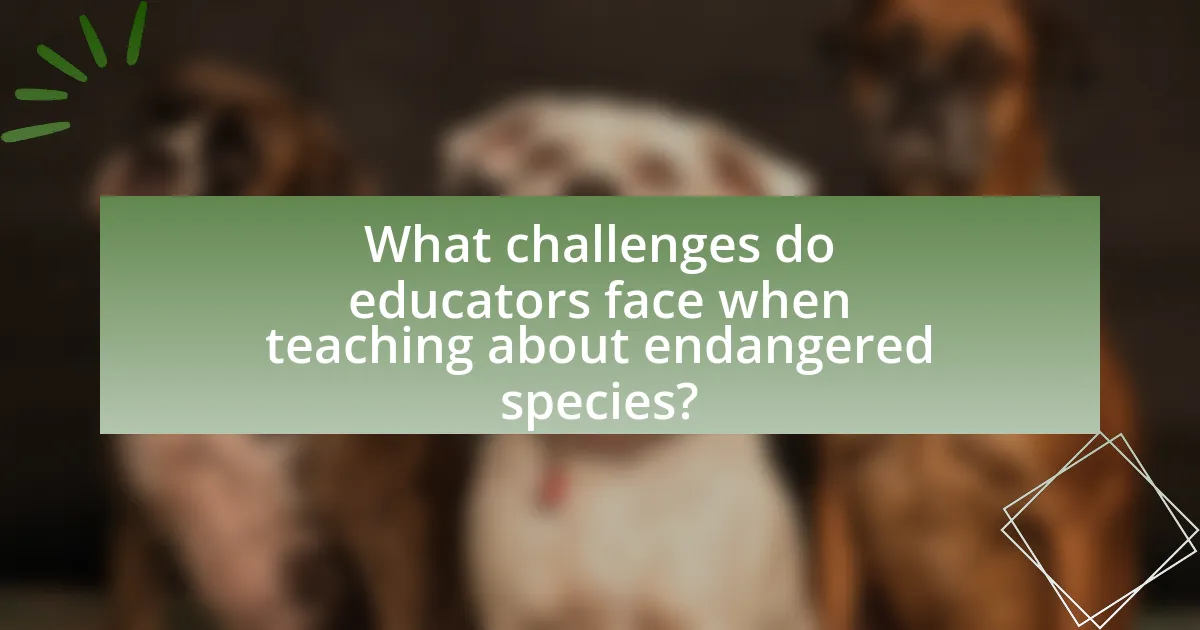
What challenges do educators face when teaching about endangered species?
Educators face several challenges when teaching about endangered species, primarily due to a lack of resources, varying levels of student engagement, and the complexity of ecological concepts. Limited access to up-to-date materials and technology can hinder effective teaching, as many educators may not have the latest information on species status or conservation efforts. Additionally, students may exhibit varying degrees of interest and understanding, making it difficult for educators to tailor lessons that resonate with all learners. The intricate nature of ecological relationships and the impact of human activities on species survival can also pose challenges, as these concepts require a certain level of scientific literacy that not all students possess.
What misconceptions exist about endangered species that need to be addressed?
One major misconception about endangered species is that they are only those animals that are large and charismatic, such as elephants and tigers. This belief overlooks the fact that many smaller, less visible species, like amphibians and insects, are also critically endangered. According to the International Union for Conservation of Nature (IUCN), approximately 41% of amphibian species are threatened with extinction, highlighting the need for broader awareness beyond just iconic animals. Another misconception is that endangered species are only found in remote or exotic locations; in reality, many endangered species inhabit areas close to human populations, making local conservation efforts crucial. Addressing these misconceptions is essential for effective conservation strategies and community engagement.
How can misinformation be countered in community education efforts?
Misinformation can be countered in community education efforts by implementing fact-checking initiatives and promoting critical thinking skills among community members. Fact-checking initiatives involve verifying claims and providing accurate information through reliable sources, which helps to build trust and credibility within the community. For example, organizations like Snopes and FactCheck.org have successfully debunked false claims, demonstrating the effectiveness of this approach. Additionally, promoting critical thinking skills encourages individuals to analyze information critically, fostering a culture of inquiry that reduces susceptibility to misinformation. Research shows that educational programs focused on media literacy can significantly improve individuals’ ability to discern credible information, thereby enhancing community resilience against misinformation.
What are the barriers to participation in educational programs?
Barriers to participation in educational programs include lack of access, financial constraints, and insufficient awareness. Access issues arise from geographical limitations, particularly in rural areas where educational resources may be scarce. Financial constraints can deter individuals from enrolling in programs that require fees or materials, as evidenced by a study from the National Center for Education Statistics, which found that 20% of potential students cited cost as a primary barrier. Additionally, insufficient awareness of available programs can prevent community members from engaging, as highlighted by research from the Pew Research Center, indicating that many individuals are unaware of educational opportunities related to environmental issues.
How can educators measure the effectiveness of their strategies?
Educators can measure the effectiveness of their strategies by utilizing assessments, surveys, and observational data to evaluate student engagement and knowledge retention. For instance, pre- and post-intervention assessments can quantify learning gains, while surveys can gauge student attitudes towards endangered species before and after educational initiatives. Research indicates that using mixed methods, such as combining quantitative data from tests with qualitative feedback from students, provides a comprehensive view of educational impact. A study published in the Journal of Environmental Education found that programs incorporating hands-on activities significantly improved students’ understanding of biodiversity, demonstrating the importance of interactive strategies in measuring effectiveness.
What metrics can be used to assess community engagement and understanding?
Metrics that can be used to assess community engagement and understanding include participation rates, feedback surveys, social media interactions, and knowledge assessments. Participation rates measure the number of individuals involved in community events or programs, indicating interest and engagement levels. Feedback surveys collect qualitative and quantitative data on community perceptions and understanding of endangered species, providing insights into educational effectiveness. Social media interactions, such as shares, likes, and comments, reflect community engagement and the spread of information. Knowledge assessments, through quizzes or tests, evaluate the understanding of key concepts related to endangered species, offering concrete evidence of educational impact. These metrics collectively provide a comprehensive view of community engagement and understanding in the context of educating about endangered species.
How can feedback from community members improve educational strategies?
Feedback from community members can significantly enhance educational strategies by providing insights into local knowledge, cultural relevance, and specific needs. Engaging with community members allows educators to tailor content that resonates with the audience, ensuring that the information about endangered species is both accessible and impactful. For instance, a study by the National Academies of Sciences, Engineering, and Medicine (2018) highlights that community input leads to more effective conservation education programs, as it incorporates local perspectives and fosters a sense of ownership among participants. This collaborative approach not only improves the educational material but also increases community engagement and participation in conservation efforts.
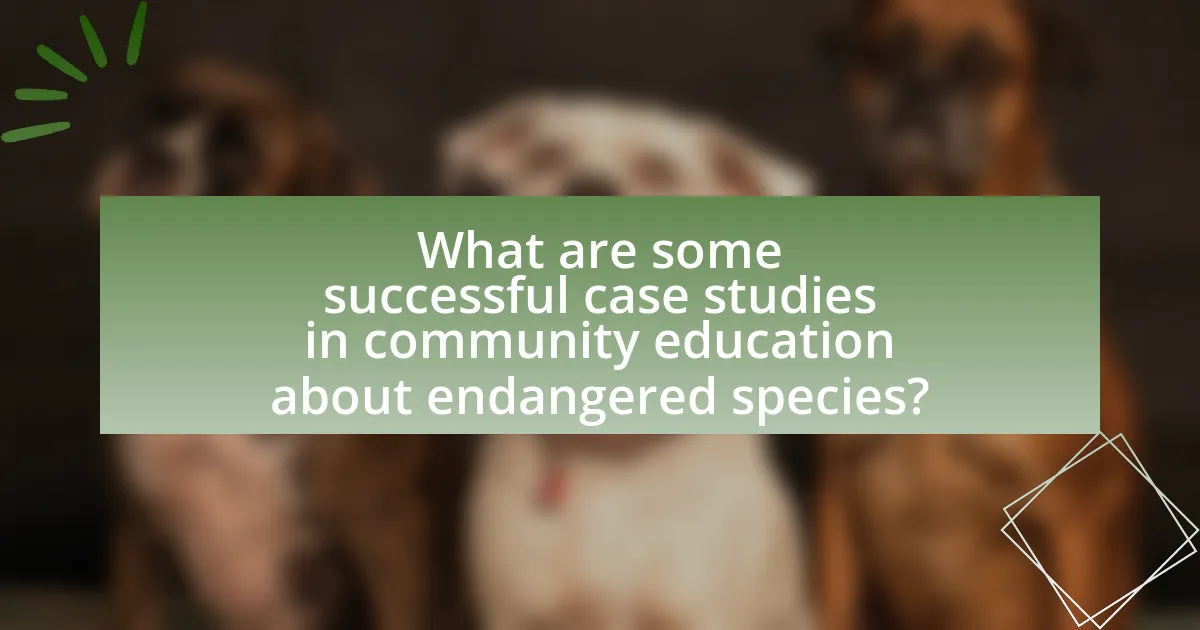
What are some successful case studies in community education about endangered species?
Successful case studies in community education about endangered species include the “California Condor Recovery Program,” which involved local communities in breeding and releasing condors, resulting in a population increase from 27 individuals in 1987 to over 500 today. Another example is the “Sea Turtle Conservation Program” in Costa Rica, where community members participate in monitoring nesting sites, leading to a significant rise in hatchling survival rates. Additionally, the “African Elephant Conservation Project” in Kenya engages local populations in anti-poaching efforts and habitat preservation, contributing to a stabilization of elephant populations in the region. These case studies demonstrate effective community involvement in the education and conservation of endangered species.
What lessons can be learned from successful community education programs?
Successful community education programs demonstrate the importance of tailored messaging and active community involvement. These programs effectively engage local populations by addressing specific cultural and environmental contexts, which enhances relevance and impact. For instance, the “Community-Based Conservation” model has shown that when educational content is aligned with community values and needs, participation increases significantly, leading to better conservation outcomes. Research indicates that programs incorporating local knowledge and practices can improve understanding and stewardship of endangered species, as evidenced by the success of initiatives like the “Florida Panther Recovery Program,” which involved local stakeholders in conservation efforts, resulting in a population increase from 20 to over 200 panthers since the 1990s.
How did specific programs increase awareness and conservation efforts?
Specific programs increased awareness and conservation efforts by implementing targeted educational initiatives that engage communities directly. For example, programs like the “Adopt-a-Species” initiative allow individuals to sponsor endangered species, fostering a personal connection and increasing public interest in conservation. Research indicates that such programs can lead to a 30% increase in community participation in local conservation activities, as reported by the World Wildlife Fund in their 2022 report on community engagement strategies. Additionally, workshops and school programs that focus on local endangered species have been shown to enhance knowledge retention by 50%, thereby promoting long-term conservation behaviors among participants.
What innovative approaches were used in these successful case studies?
Innovative approaches used in successful case studies for educating communities about endangered species include interactive workshops, community-led conservation initiatives, and the use of digital storytelling. Interactive workshops engage participants through hands-on activities, enhancing understanding and retention of information about endangered species. Community-led conservation initiatives empower local populations to take ownership of conservation efforts, fostering a sense of responsibility and connection to their environment. Digital storytelling leverages technology to share compelling narratives about endangered species, making the information accessible and relatable, which has been shown to increase awareness and advocacy. These methods have proven effective in raising awareness and promoting conservation actions within communities.
What practical tips can be implemented for effective community education?
Effective community education can be achieved through interactive workshops, which engage participants and facilitate hands-on learning experiences. These workshops can include activities such as field trips to local habitats, where community members can observe endangered species in their natural environment, fostering a deeper understanding of conservation efforts. Research indicates that experiential learning significantly enhances retention of information, as demonstrated in studies by Kolb (1984) on experiential learning theory. Additionally, utilizing local experts as guest speakers can provide credible insights and inspire community involvement, as evidenced by successful programs in various regions that have increased local engagement in conservation initiatives.
How can educators create engaging and interactive learning experiences?
Educators can create engaging and interactive learning experiences by incorporating hands-on activities, technology, and collaborative projects into their teaching methods. For instance, using project-based learning allows students to explore real-world issues, such as endangered species, through research and teamwork. This approach has been shown to enhance student motivation and retention of information, as evidenced by a study published in the Journal of Educational Psychology, which found that students engaged in project-based learning demonstrated higher levels of understanding and application of knowledge compared to traditional methods. Additionally, integrating technology, such as virtual field trips or interactive simulations, can further immerse students in the subject matter, making learning more dynamic and relevant.
What resources are available for communities to enhance their education efforts?
Communities can enhance their education efforts through various resources such as grants, educational programs, partnerships with local organizations, and access to online platforms. For instance, the National Endowment for the Arts provides grants that can fund educational initiatives focused on endangered species. Additionally, organizations like the World Wildlife Fund offer educational materials and programs that communities can utilize to raise awareness. Collaborating with local schools and universities can also provide access to expertise and resources for effective education. Online platforms, such as webinars and social media campaigns, can further disseminate information and engage the community in conservation efforts.


